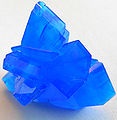EZ Water (aka Living Water, The Fourth Phase of Water, Crystalline Water, Ordered Water, Organized Water, Hexagonal Water, Alkaline Water, H3O2) Confirms Water has Strange Properties – Hygroscopy and Water of Crystallization
How Does EZ Water (aka Living Water, The Fourth Phase of Water, Crystalline Water, Ordered Water, Organized Water, Hexagonal Water, Alkaline Water, H3O2) Confirm Water has Strange Properties? Let’s Consider “Hygroscopy” and “Water of Crystallization”.
In the book The ‘Mystical’ TCM Triple Energizer’. Its Elusive Location and Morphology Defined (1), I show that the ancient Chinese medical classic, Nan Jing (2), teaches that ‘the water-ways of the entire body originate from the Triple Burner’, and that ‘the biological and energic influences throughout the entire body are transformed from water’. Accomplished scholar, Yeh Lin, stated ‘All of that rests on the principle that when fire meets water, a transformation into influences takes place’. Exactly how does this “transformation into influences take place” and how does normal water become “living water”? I believe that recent scientific research into the unique properties of water by numerous prominent scientists illuminates the mechanism by which energy is manufactured in the body, how cellular ion pumps and enzymatic reactions occur throughout the body. Enzymes are the ‘archetypal quantum molecular energy machine’ as they massively reduce the time required for biochemical reactions to occur in organisms by a factor of 1010 to 1023. Many scientists now believe that these abundant biological and biochemical processes occur directly due to water which is ubiquitous throughout our body, constituting 99% of our body on a molecule per molecule basis.
I propose that once “normal” water is consumed it is “transformed into influences” due to the intimate association of the “normal” water alongside the hydrophilic (water-loving) Connective-Tissue Metasystem comprised of piezoelectric, semiconductor collagen protein. In my book The ‘Mystical’ TCM Triple Energizer. Its Elusive Location and Morphology Defined, I show that the San Jiao Organ is actually the omnipresent hydroelectric station that is ubiquitous throughout the body, producing numerous liquids and fluids (sweat, blood, tears, urine, saliva, semen, gastric juices, fingerprint oil etc.) and numerous forms of energy (qi) that engender ‘life’. The numerous synonyms for EZ above have been proposed by numerous researchers examining water from differing perspectives.
Below I discuss just two of the remarkable and unique properties of water, namely how water is naturally highly attracted to many diverse inorganic and organic substances. Remarkably, water is so attracted to some solids that the water will be attracted to such an extent it will liquefy the formerly dry substance. This incredible affinity for water is shown in the fact that many inorganic and organic substances will form solid crystalline structures holding large reservoirs of water, and yet remain dry and solid. This same characteristic of water is shown by the remarkable fact that molecule-for-molecule, humans are 99 percent water. This is why many enlightened scientists have confirmed the vast amount of water in our body in liquid crystalline in nature.
My easy-reading educational book is essential for anyone wanting to know more about how “normal” bulk water is converted within the ubiquitous hydrophilic Connective-Tissue Metasystem within the body into life-sustaining EZ water that is critical for optimal human health and wellbeing, hence called “living water”. This educational book can be securely purchased by clicking the ‘BUY NOW’ button at the bottom of this page.
The Water Property of Hygroscopy in Non-Living Inorganic and Organic Situations
While water has some very strange chemical properties, biologists don’t seem to take into account that if those strange properties of water exist in non-living situations, perhaps those same strange properties might exist also in living organic situations. Take for example, the phenomenon of Hygroscopy. Wikipedia (3) states:
Hygroscopy is the phenomenon of attracting and holding water molecules from the surrounding, usually at normal or room temperature, environment. This is achieved through either absorption or adsorption with the absorbing or adsorbing substance becoming physically changed somewhat. This could be by an increase in volume, boiling point, viscosity or other physical characteristic and properties of the substance, as water molecules can become suspended between the substance’s molecules in the process (emphasis is mine).
The article further notes that cellulose fibers (such as cotton and paper), sugar, caramel, honey, glycerol, ethanol, wood, methanol, sulfuric acid, many fertilizer chemicals, many salts (including table salt), and a wide variety of other substances are also hygroscopic in nature. Note that both inorganic (e.g. table salt, sulfuric acid) and organic (e.g. paper, sugar, wood) substances are known to be hygroscopic in nature.
The article further states, ‘Zinc chloride and calcium chloride, as well as potassium hydroxide and sodium hydroxide (and many different salts), are so hygroscopic that they readily dissolve in the water they absorb: this property is called deliquescence’. Interestingly, while concentrated sulfuric acid is hygroscopic in nature, even diluted solutions down to concentrations of 10 Vol-% or below, are also still hygroscopic.
The article continues, ‘A hygroscopic material will tend to become damp and cakey when exposed to moist air (such as the salt inside salt shakers during humid weather)’. Remarkably, the article continues, ‘Because of their affinity for atmospheric moisture, hygroscopic materials might require storage in sealed containers’.
Based on the property of “hygroscopy” I posset three questions: Q1 – Do these numerous types of substances discussed above really have a strong affinity for water? Q2 – Alternatively, is the reality that water actually has a strong affinity for all of these numerous diverse substances? Remember, water is the only substance in common. Q3 – Just how strongly does the atmospheric water bond via absorption or adsorption to these diverse substances and chemically-dissimilar materials? This brings me to another marvellous water-related chemical property, namely “water of crystallization”.
Waters Affinity for Some Inorganic and Organic Molecules Leads to Water of Crystallization
In the article titled Water of crystallization (4) the authors state, ‘In chemistry, water of crystallization or water of hydration or crystallization water is water that occurs inside crystals’. They note that water is often required for crystals to form. They further state, ‘Classically, “water of crystallization” refers to water that is found in the crystalline framework of a metal complex or a salt, which is not directly bonded to the metal cation.’ Examples of hydrated salts are Calcium chloride hexahydrate, Aluminium chloride hexahydrate and Cobalt(II) chloride hexahydrate, with chemical formulae respectively CaCl2(H2O)6, AlCl3(H2O)6 and CoCl2(H2O)6.
Regarding the availability of the liquid water locked up in crystals, the authors state, ‘Upon crystallization from water or moist solvents, many compounds incorporate water molecules in their crystalline frameworks. Water of crystallization can generally be removed by heating a sample but the crystalline properties are often lost’.

The article notes that while hydrated copper(II) sulfate is bright blue, anhydrous copper(II) sulfate is white. I think it is incredible that the inclusion of water in the white anhydrous copper(II) sulphate crystals makes the hydrated copper(II) sulfate bright blue. I think it is also amazing that while water is locked up in the crystal, in spite of the water presence the crystal is dry and hard. How can that be so? While frozen water in the form of ice is certainly hard, simple touching a block of ice will wet your hands. Yet touching crystals that contain even large amounts of “water of crystallization” will assure you that they are absolutely “dry”. Regarding this fascinating fact pertaining to inorganic salts, the authors state, ‘Compared to inorganic salts, proteins crystallize with unusually large amounts of water in the crystal lattice. A water content of 50% is not uncommon’.
Are Water Molecules Responsible for Biological Processes Including Energy Production and Enzymology in Living Systems?
I think it is remarkable that chemists and biologists acknowledge that water is readily locked up in biological organic proteins up to 50% in the laboratory, and that water locked up in inorganic salts, e.g. copper(II) sulphate cause reproducible crystalline shapes that are brilliant blue all thanks to the water therein. Strangely, many of those same chemists and biologists do not consider this massive affinity of proteins for water to come into consideration for biological processes including energy production and enzymology in living systems including humans.
Water’s Involvement in Copper Sulphate Crystals Related to TCM San Jiao Organ
I propose that just as water’s unique and dynamic properties are intimately involved in the specific crystalline morphology and the blue colour materialization of e.g. copper(II) sulphate crystals, water’s unique properties are intimately related to TCM’s San Jiao Organ, which the ancients appreciated, as they stated ‘the biological and energic influences throughout the entire body are transformed from water’.
REFERENCES:
(1) Gordon, L., The ‘Mystical’ TCM Triple Energizer. Its Elusive Location and Morphology Defined. Xlibris Press, Australia. 2016.
(2) Unschuld, P. U., Nan Ching: The Classic of Difficult Issues (e-book edn, Los Angeles: University of California Press, 1986), 771. With commentaries by Chinese and Japanese authors from the third through the twentieth century.
(3) Wikimedia Foundation Inc., ‘Hygroscopy’ (updated 14 November 2016). Available from <https://en.wikipedia.org/wiki/Hygroscopy>
(4) Wikimedia Foundation Inc., ‘Water of crystallization’ (updated 12 December 2016). Available from <https://en.wikipedia.org/wiki/Water_of_crystallization>
ACKNOWLEDGEMENT:
I wish to sincerely thank Dr Paul U. Unschuld for the selfless and tireless work he has committed to make many ancient Chinese medical classics available in English for study and research. My book is based predominantly around his scholarly work ‘Nan-Ching: The Classic of Difficult Issues’. I also wish to sincerely thank Professor Unschuld for permission to use citations of his translation in my book. His translation of ‘Nan-Ching: The Classic of Difficult Issues’ can be purchased from the following link: https://www.amazon.com/Nan-ching_The-Classic-Difficult-Comparative-Studies/dp/0520053729





